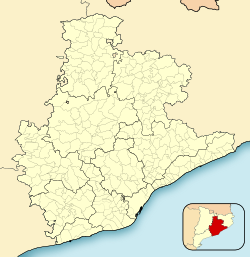Manresa
| Manresa | |||
|---|---|---|---|
| Municipality | |||

Seu of Manresa
|
|||
|
|||
| Location in Catalonia | |||
| Coordinates: 41°43′46″N 1°49′38″E / 41.72944°N 1.82722°E | |||
| Country |
|
||
| Community |
|
||
| Province | Barcelona | ||
| Comarca | Bages | ||
| Government | |||
| • Mayor | Valentí Junyent Torres (2015) ((CiU)) | ||
| Area | |||
| • Total | 41.6 km2 (16.1 sq mi) | ||
| Elevation | 238 m (781 ft) | ||
| Population (2014) | |||
| • Total | 75,297 | ||
| • Density | 1,800/km2 (4,700/sq mi) | ||
| Demonym(s) | Manresà | ||
| Website | manresa |
||
Manresa (Catalan pronunciation: [mənˈrɛzə]) is the capital of the Comarca of Bages, located in the geographic centre of Catalonia, Spain, and crossed by the river Cardener. It is an industrial area with textile, metallurgical, and glass industries. The houses of Manresa are arranged around the basilica of Santa María de la Seo.Saint Ignatius of Loyola stopped to pray in the town on his way back from Montserrat in 1522. He also read in solitude in a cave near the town for a year, which contributed to the formulation of his Spiritual Exercises. As such, the town is a place of pilgrimage for Catholics.
It is believed the comarcal name "Bages" comes from a corruption of the Latin "Bacchus" due to the extensive production of wine in the area. The wine was grown mainly in terraced vineyards, and many of these old terraces can be seen today. Wine ceased to be the main product of the area as a consequence of phylloxera, but is still a very important part of the Manresa/Bages economy.
During the Napoleonic invasion, the volunteer troops of Manresa (sometent in Catalan) defeated the French troops in the Bruch Pass (June 1808), but the retreating French burned and demolished much of the town. After the expulsion of Napoleon's troops, Manresans rebuilt the town using the rubble.
In the 12th century Manresa was said to have contained 500 Jewish families, most of whom lived in a narrow lane called "Grau dels Jueus," near the town hall; their cemetery, still called "Fossana dels Jueus," was outside the city. In the 13th and 14th centuries the Jews there were engaged in manufacturing, trading, money-lending, and in the cultivation of their vineyards and estates.
...
Wikipedia




